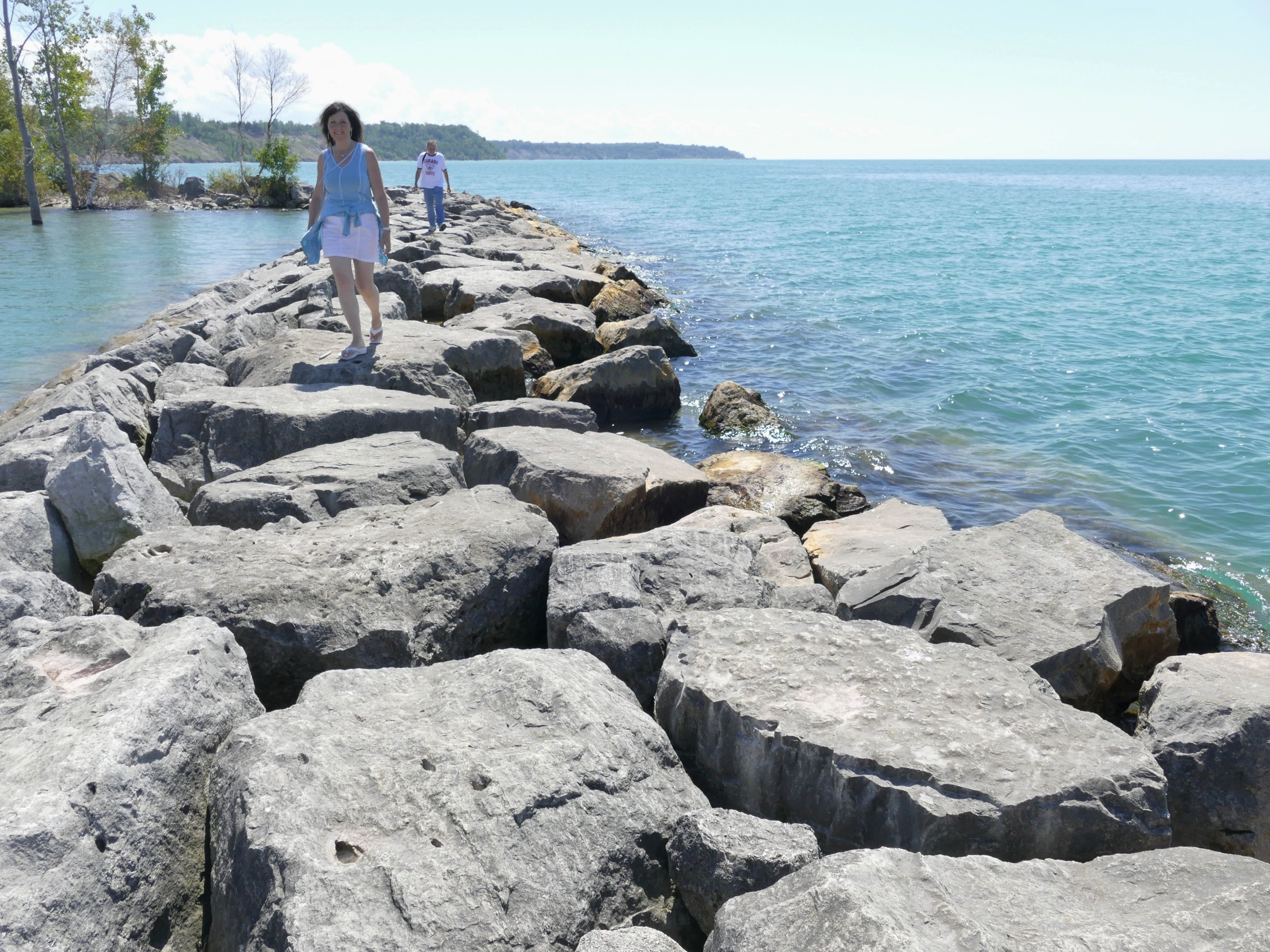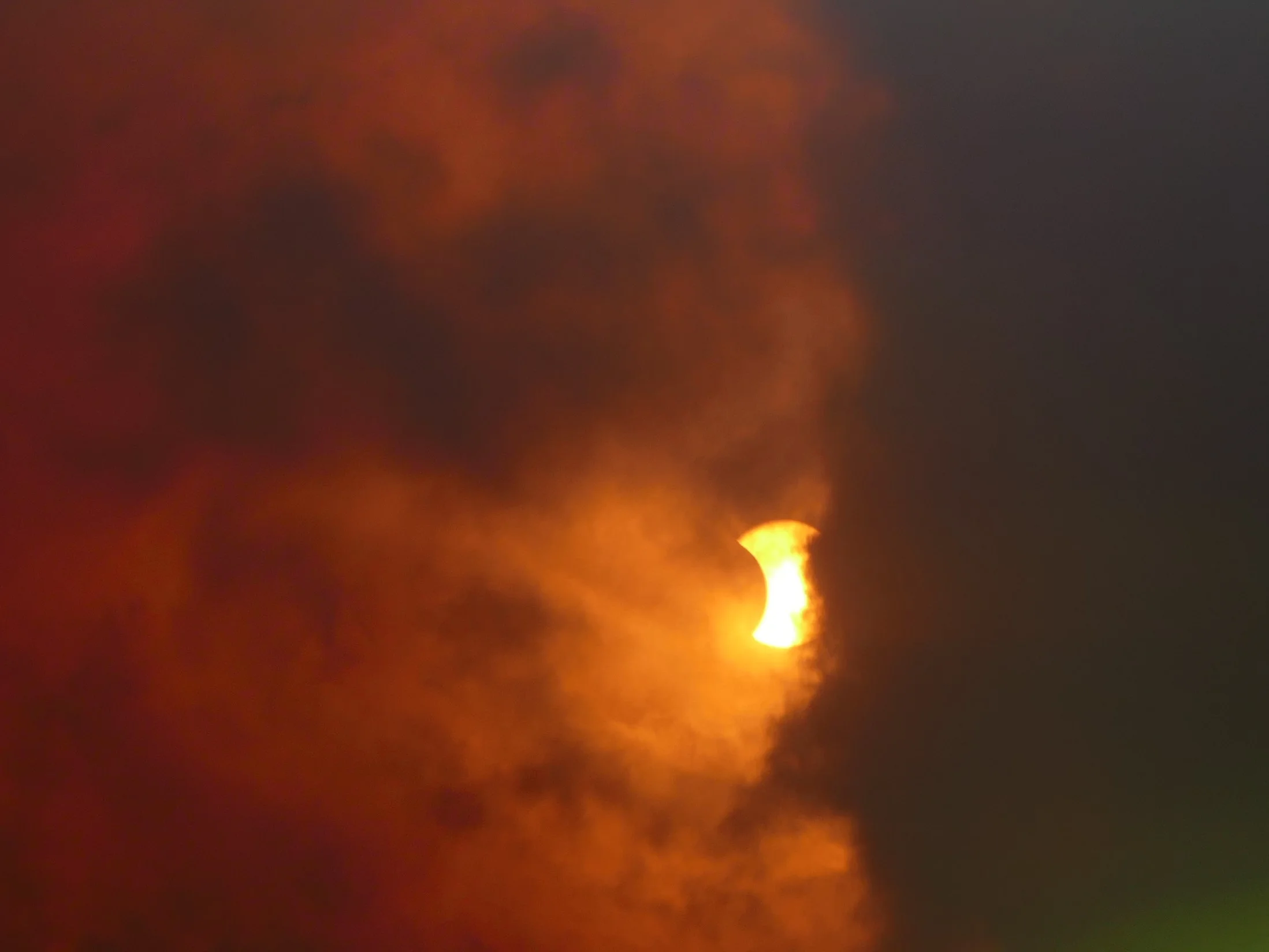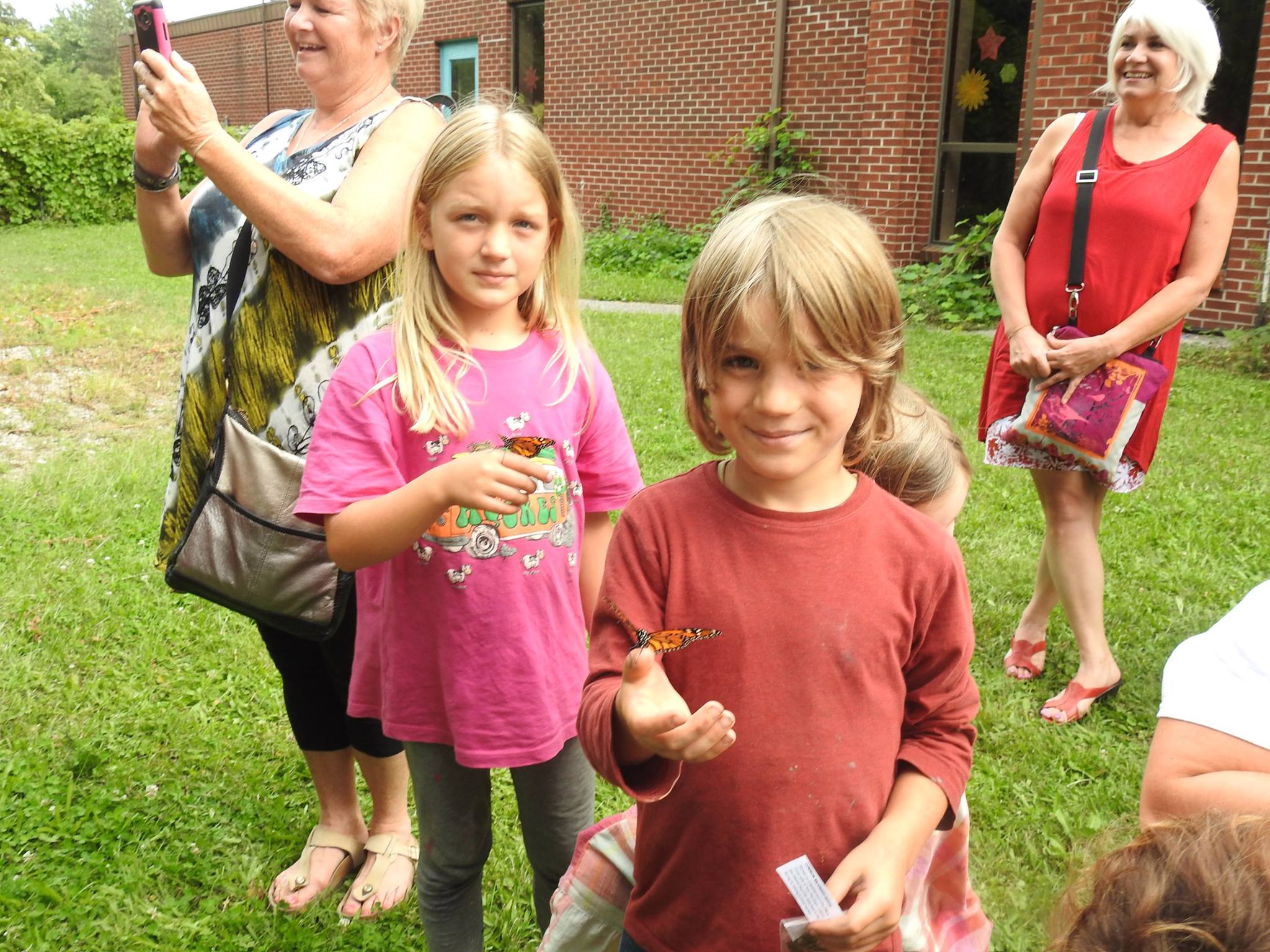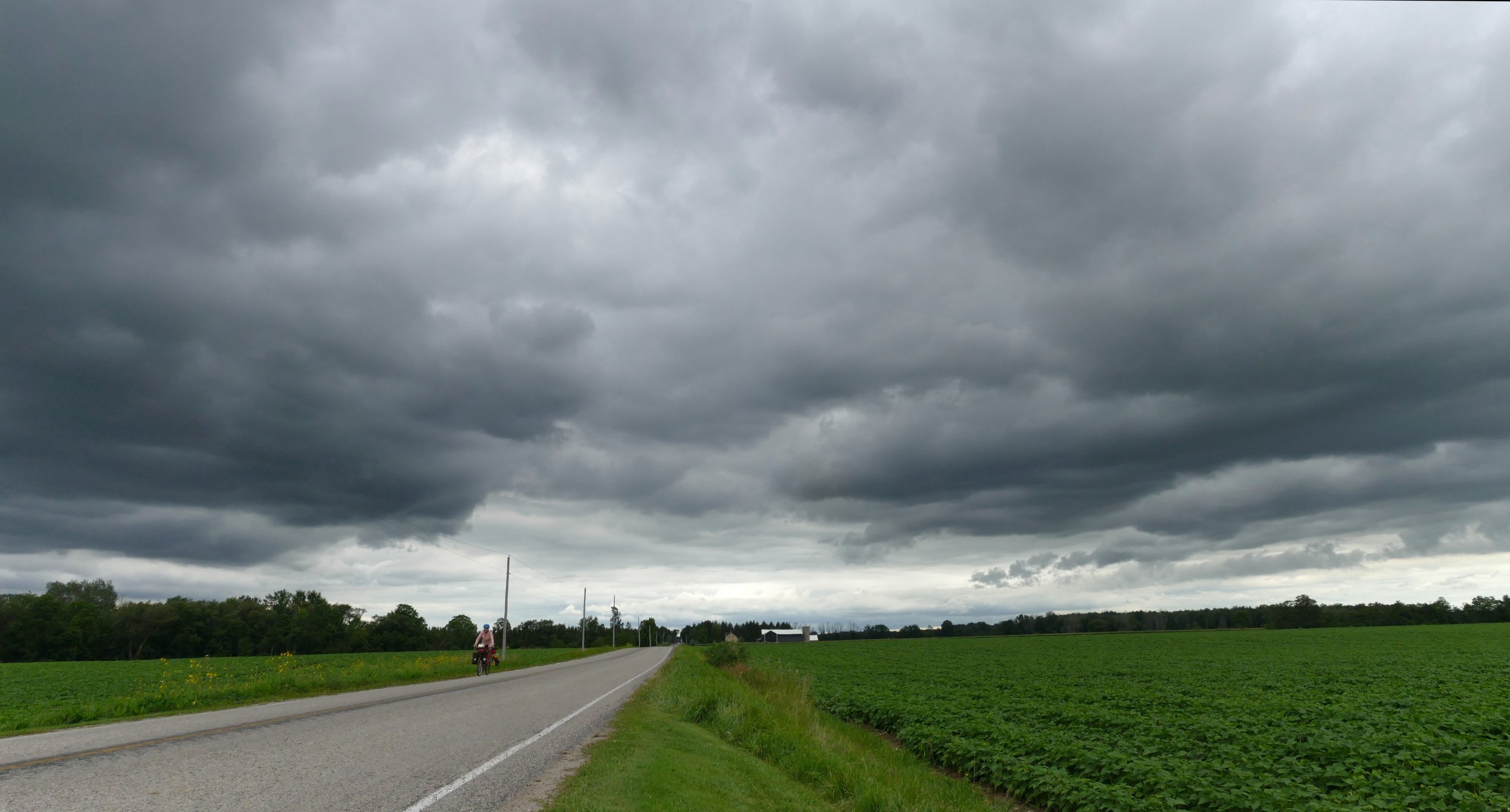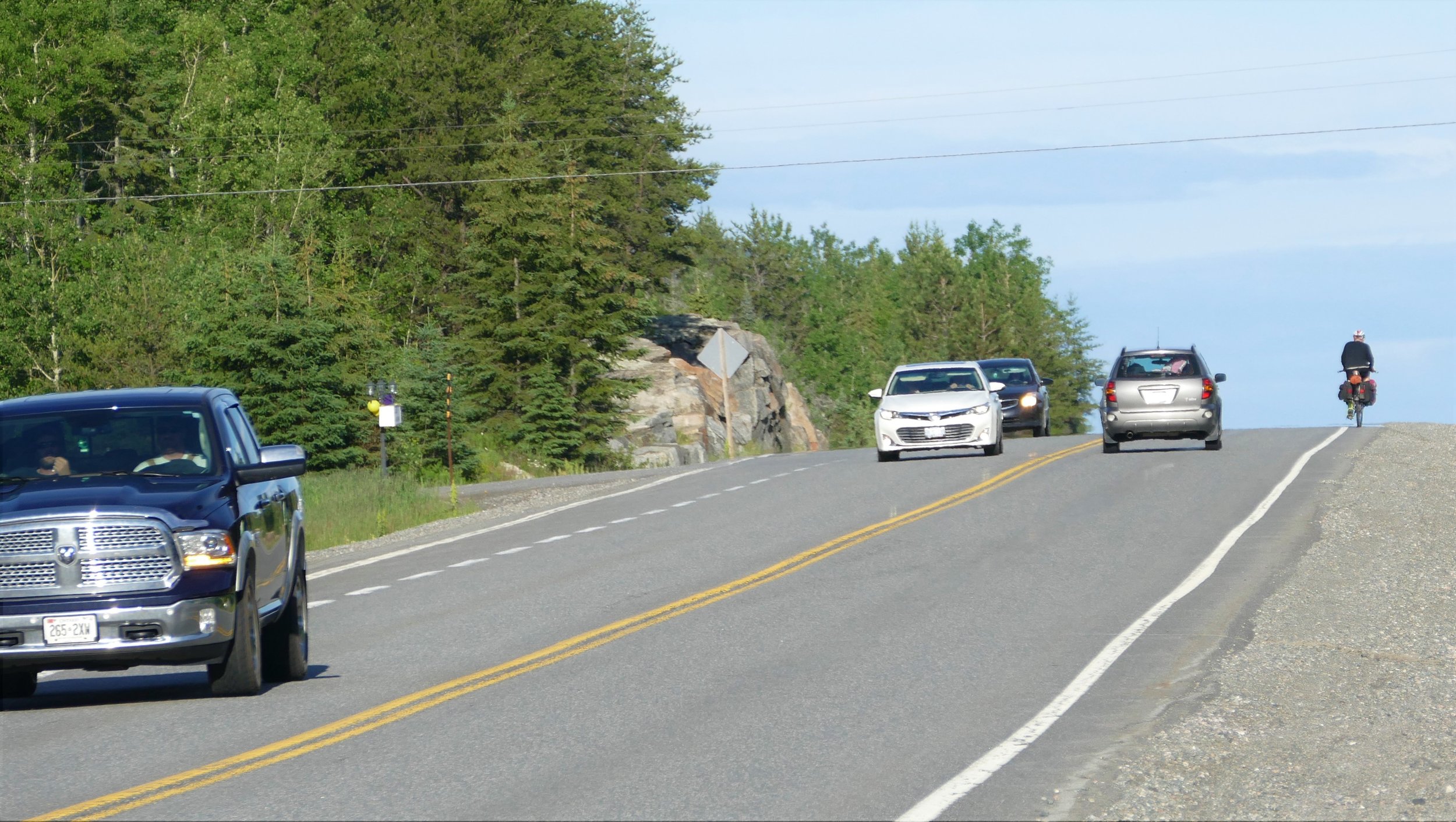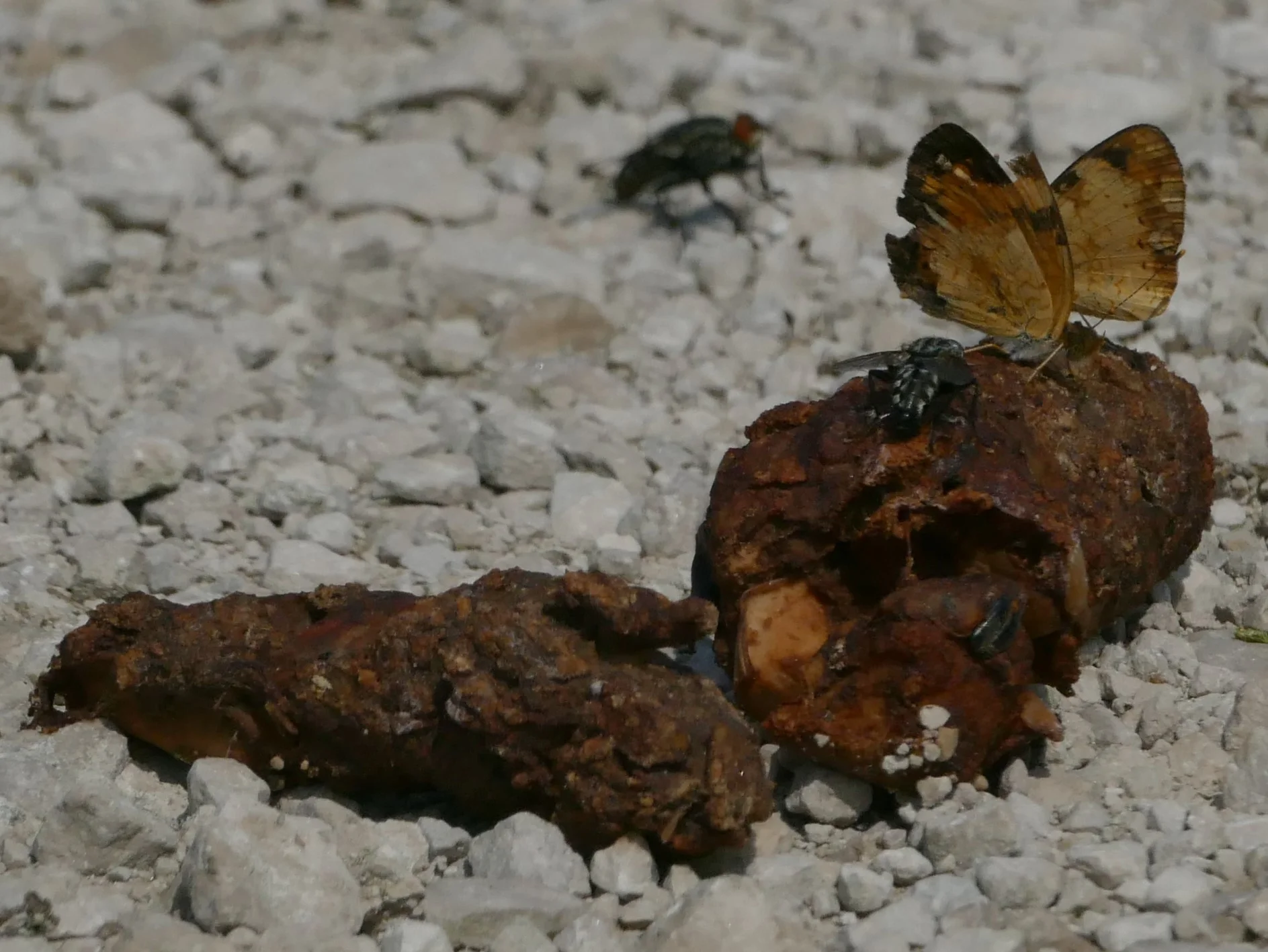Originally my route took me through Canada only once but after a few emails from some passionate monarch stewards it was clear that the energy in southern Ontario couldn’t be passed up. This energy, after all, is the commodity that makes my trip more than a bike ride. It is the resource I need to connect my trip to audiences and media. Alone, my voice is quiet, limited by the necessity of splitting my time between scheduling, networking, presenting, documenting, updating, OH AND BIKING! So when people with energy offer their support, expertise and help, I do my best to take advantage of it. I’m 99% glad I changed my route to visit Southern Ontario.
Southern Ontario wasn't originally on my route, but I am 99% glad I made the detour.
I’ll hold off ranting about the bad 1% not because I am worried it will taint my memories of Southern Ontario (it won’t) or because it will make my blood boil (it will) but simply because it was literally the last thing that happened to me while I was in Canada. First I should mention the former and better 99%.
Crossing into Canada went smoothly enough, considering the construction, mandatory bike shuttles, complete lack of signage for cyclists and the general chaos of border crossings. The woman at Canadian Customs grilled me like I had never been grilled at a border before. She ran through all the weapons I might have. Gun? No. Knives? No. Pepper spray? No. Finally she asks with contempt, “then how do you protect yourself?” I nearly laughed but thought better of it. Instead I smiled and told her that “I run fast.” The idea of carrying weapons on my tour seems beyond possibility. I would never feel safer with a gun, and I think having a gun would change the trust equation I rely on. Trust + vulnerability + awareness + common sense + rationality + luck = bike touring.
Camp spots like this one would feel scarier if I had weapons.
My first night in Canada was one of only four nights I camped in Ontario. I camped at the far end of a sporting complex/Catholic church/Catholic school. The grass was cut so I figured no one would be out mowing in the morning. This thought occurred because one morning in Minnesota I had been woken up by a man mowing around my tent. He acted as if I was simply another tree or piece of playground equipment and while he didn’t seem annoyed I much prefer an alarm clock to a lawn mower. Next I ruled out other possible factors that could lead to a stressful morning: church crowds and students. The next day was a weekday, so there wouldn’t be a church crowd, and school was not yet in session. It was perfect, and so was my timing. I arrived in the dark, right before rain and thunder took over the night. I slept well, preparing mentally and physically for the barrage of upcoming presentations and conversations which are the life of my trip but more exhausting to me than uphills, headwinds, and long mile days.
The other nine nights I stayed in houses, full of food and hospitality and often dozens of growing monarchs. I debated the best way to tell this story without creating a small digest, but then decided a digest would work just fine.
Stop 1: Barb in Hamilton: Barb was a friend of a friend and my first indoor stay in Ontario. She lived close to the Royal Botanical Gardens, where my first presentation was, giving me the opportunity to have a shower and do laundry beforehand (you're welcome!). Barb was an adventurer in her own right, and she used her skills of packing for ski and canoe trips to pack me several meals to go. Her secret: freeze portions of the meal to keep everything un-freezable cold. In this way, your meal is thawing while cooling while you work up an appetite.
Barb used her camping skills, recycled bags, and frozen food to pack me several meals for the road.
Stop 2: Than at Greenway Blooming Center: My presentation at the garden center was attended by some of the most experienced and knowledgeable monarch folks in Canada. I felt a bit ridiculous explaining to them what milkweed looks like and the stages of metamorphosis, BUT they were gracious and patient and supportive. Instead of biking away right after my presentation I had a meal with several of these characters and then stayed with Than, the owner of the garden center, and her family. Inside, I had my own room and space to do my thing, while outside it rained!
My presentation at Greenway was full of monarch heros and I was treated like a celebrity.
I love when the media cover my trip, because it means more and more people will hear the story of the monarch.
Stop 3: Barb in Stratford: Barb was one of the ladies that wrote me months before I started biking to tell me I had to come to southern Ontario. She made sure I was not disappointed, organizing a presentation, meet and greet, and media coverage. She also organized a few outings, including several tours of Stratford’s many (and award-winning) gardens and the benches nestled between the flowers (I started teasing her for pointing out all the benches which were on her mind, because she was in the process of buying more benches for another garden). And like the monarch caterpillars she raised, she kept me well fed.
Part of my garden tour with Barb was by bicycle!
Barb, and her husband Mark, showed me the sites and monarch hot spots!
Thinking back, Barb’s monarch caterpillars and I had more in common that just getting fed. We also were presented to the community to raise awareness about the migration and bring more people into the fold. I did this with meet and greets, presentations, and tours. The caterpillars do this by creating up close experiences. Barb has given students, friends, neighbors, and business leaders caterpillars so that they can watch them eat, grow, pupate, and eclose. She dedicates each adult to a person going through an intense experience, letting them whisper to orange wings and send prayers to the heavens. It is easy to be skeptical until you hear her stories. She has not only helped people process emotion, but she has introduced so many people, across a broad spectrum of lives, to the monarch.
I was able to release one of Barb's monarchs and I enjoyed hearing her stories of monarch magic.
Stop 4: Bruce in London: Bruce was an ideal host. He is a cyclist and monarch guy, so he knows exactly what cyclists need and we could talk beyond the basics of the monarch migration. Beyond the inevitable monarch conversations, we talked canoe adventures, natural history collections, ink paintings, his other cycle tourist guests, though we always ended up circling back to talk of the monarch. Bruce has been working with monarchs for some time. He has tagged monarchs for many years, and kept incredible records. He might not be a paid biologist but he is certainly a biologist.
Monarchs, biking, art, canoes, collecting random bones and stones...Bruce and I had a lot in common!
Stop 5: Darlene in Point Pelee: Darlene greeted me by bike and we rode a few kilometers to her house, one block north of Canada’s southernmost street and national park, Point Pelee. Point Pelee is known for its monarch migration and during my stop we visited the shores several times looking for clustering monarchs and the start of the migration. Darlene has been doing monarch counts there for some time and brings a passion to the park. She has invested in not just raising monarchs but in interpreting the migration by studying the monarchs at dusk. It was fun to walk through the forests flanked by waters that had surfaces of many moods. We watched the eclipse when the water was calm and welcoming, and provided me a moment to swim in my 5th Great Lake (just minutes before rangers warned folks to stay out of the water because of possible blue green algae blooms…I’m fine). Later we watched the sun set on angry, churning waters that spat out waves warning us to stay as far away as possible. One night, our drive was interrupted by hundreds of young leopard frogs crossing the road. I was beyond grateful that Darlene took the time to go slow and avoid them. Her compassion saved many frogs, and was a reminder that it is not always convenient to share the planet, but important all the same. Being a little less entitled goes a long way.
In the few miles Darlene and I biked together we saw dozens of monarchs and milkweed patches.
Got to see the eclipes come and go over Lake Erie.
Stop 6: Louie in Lakeview. Louie is a monarch guy, a traveler, and photographer that happened to live just a few kilometers from my last presentation stop. Not only was his house beyond convenient, he was beyond welcoming. His house was surrounded by a moat of plants, an oasis in a sea of pavement and grass. The proof, that yards can be habitat, was in his small ponds, which even during the slight cold front, were guarded by frogs hesitant and weary, but at home in the neighborhood. Even his driveway was habitat, an organized explosion of potted plants, a living testament to hard work, generosity, and care. His yard was in stark juxtaposition to his neighbor’s sterile green lawn. I believe changing our perception of beauty, which until now has often been modeled by companies invested in mowers and herbicides, is key to the culture shift needed to save the monarch. Green grass is a waste of space and ugly. Flowers, life, layers of homes and habitats, now that is beautiful!
Louie is a great example of what our yards could look like. Even his driveway was habitat for so many critters, including frogs!!!
For each stop, I not only had the opportunity to hear stories of monarch folks doing their thing for the monarchs, but I got to share my story too. For each stop I had a presentation, and thus the opportunity to be a voice for the monarch, and not just bring new folks into the Southern Ontario monarch team, but to remind everyone already fighting for the monarch that they are not alone. That while they might work in the bubble of their neighborhood, I have cycled between their towns, and have seen that they are part of something big.
I came to this conclusion after doing six presentations in 11 days. After each presentation I met more people fighting for the monarchs in their own quirky ways, realizing the full extent of the monarch network. Across North America (and beyond! Shout out to Jacqui Knight who helps edit this blog from New Zealand), there is a group of committed, passionate people, linked by the monarchs and the internet. Many know more of the lingo and science than I do. They grow milkweed beside their houses, and know where every local milkweed patch in. They share their yards with wild creatures at the mercy of human decisions, and many of them share their time and living rooms with developing eggs, caterpillars, and chrysalides. They share what they learn and observe and wonder with this network, and debate the latest insights. I call them crazy monarch people. With emphasis on the word crazy, which in my mind is the opposite of boring. Crazy is good.
Crazy enough to make butterfly shaped waffles? I hope so!!!!
To me, crazy is passion and dedication and doing something beyond the day-to-day motions of living. To be crazy is to be alive, thinking and learning, a part of the world. I never would have imagined this crazy monarch world existed before my trip, but there it is, reaching out from town to town, spreading and growing; a peaceful army fighting for a butterfly and making my trip possible.
As I type this, I realize I should probably rethink my word choice. Because one could argue that these people I’ve dubbed crazy monarch people for their passion and dedication, are in fact the sanest people I’ll meet. They have begun to connect the dots between our lives and our planet. It is not crazy at all to demand our Earth be healthy enough for monarchs, or find inspiration in the smallest details of nature. It is not crazy to appreciate the uniqueness of each creature, each flower, and each roadside ditch. In reality NOT fighting, not caring, not noticing, well, THAT is crazy.
To be clear, I consider myself crazy too!
Whatever I call them, I’ve found these sane/crazy monarch people and the web that connects them all over North America, but it was in Southern Ontario where the network seemed the most concentrated, the most inclusive, and the most enthusiastic. I’ve spent many miles wondering where this concentration came from. Thinking back now, I realize I never asked any of them why they thought their monarch family was so big, but I have my theories.
For starters, Southern Ontario is a hot spot for monarchs thanks to the Great Lakes and weather patterns funneling the monarchs to the southernmost tip of Canada. Because of this, there seem to be more monarchs to catch the attention of residents, and the high population helped build a sense of pride. The sense of pride was also cultivated by many years of innovative science from the famous monarch biologist Fred Urquhart. Urquhart started tagging efforts on the shore of Lake Erie in 1937 to learn where the monarchs went each winter. In 1952 he began seeking volunteers to help with the tagging efforts, and by including volunteers in the mission he was able to not only learn that the monarchs travel to Mexico but create a culture of monarch science that is still seen in Ontario today. I met several people that tagged monarchs with Urquhart, including Don Davis, one of the most down to earth monarch stewards I have yet to meet, and John Powers, one of the biggest personalities in the monarch world.
John and Don, two leaders in the monarch world.
Beyond location, it seemed to me the concentration of crazy monarch folks came from their contagious passion and energy. What likely began with a few has spread like ripples on a lake, each connection and invitation to join the cause a pebble thrown into the water. Over time the newly inducted begin reaching out in their own ways, adding their own ripples, until the entire lake is a white water of dedication. From what I saw, one of the most effective ways people in Ontario have found to introduce people to the monarch, to make ripples, is by rearing caterpillars and releasing the adults ceremoniously.
Now, I entered the world of the monarch by “hunting” them in ditches and wild lands, but another way is to raise them in captivity. In Ontario, I met loads of people that raise monarchs as a way to introduce others to the astonishing metamorphosis. In Stratford, Barb gave nearly full grown caterpillars (or cats as us crazies call them) to schools and businesses; In London, Bruce gave cats to the local library; and at Point Pelee, Darlene gave cats to the National Park Visitor Center. In each case, monarch newbies could watch up close the colorful caterpillars eat, then pupate, eclose, and then finally they could hold the recently emerged butterflies on their palms and watch “their” butterfly fly through the sky for the first time.
I discovered the world of the monarch by entering their world. Another way is to bring a few caterpillars into our world to watch the mystery unfold.
Each reared caterpillar becomes a lesson that leads to understanding, appreciation, and stewardship. And while we can’t save monarchs by rearing caterpillars, we can save monarchs by connecting as many people as possible to their story. It is harder to ignore the monarchs’ plight when you’ve watched a butterfly emerge into the world and test its new body slowly. And once “our” monarchs have been released back to the wild they live in our hearts and the world looks different from then on. In this way I believe rearing cats, and sharing the process with community, is one of the reasons the concentration of crazy monarch people in Ontario is so high.
Raising monarchs is a great way to get folks interested in the migration. It is a great first step.
For this reason, my opinion on raising monarchs shifted during my stay. I still believe that we need to remain skeptical. I still believe we need to remind ourselves of our lack of knowledge, and that we are removing a wild creature from the wild. And I still think we need to remember that we don’t know or understand all the pieces and that our actions have consequences, good and bad. BUT I see the value in raising monarchs. I see the value in collecting eggs and caterpillars from vulnerable milkweeds growing on private lands, roadside ditches, and between crop rows; giving entire generations an escape from the uniformed. I also see the importance of bringing monarchs into our world, so we can be a part of theirs.
For me though, my southern Ontario run was not about the world of the monarch. It was more about the world of the people fighting for the monarchs, and finding the proof that together we can give the monarch a future. I found the proof in the abundant monarch gardens and waystations, in the large (for me) crowds at my presentations, and the growing demographics of monarch stewardship. And in this world I was privy to the hospitality afforded to the monarchs and extended to me, especially when it came to food!
There were so many people in Ontario interested in monarchs. I saw what happens when people use their voices to build their communities and grow a movement.
By my third or fourth stop, I realized I was being observed and notes were being made about my food preferences. Soon word had spread as to my favorite dishes. I found it both incredibly thoughtful but also like that game of telephone where each version of the sentence subtly changes as it progresses though each listener. A sentence like “I like peanut butter” when offered peanut butter, slowly filtered through the network until it read “I LOVE PEANUT BUTTER AND CAN’T LIVE WITHOUT IT”. As a not picky eater, I like just about everything, and honestly I can eat anything, even things I don’t much want to eat. I simply appreciate the offer!
I'll eat just about anything, EVEN homemade biscotti from an Italian (just in case the joke is lost: the biscotti was great and was not difficult to eat :)
Take for instance, a day in Peru. My friend Nia and I were graciously waiting for some rice at the house of a women we had met on the road while biking. While the rice did its thing, the women brought out this mushy pumpkin mess that might have been the grossest thing I have ever eaten (even though I was beyond hungry). It was not good, so I ate it as fast as I could. She interpreted this as a thumbs up and figured I wanted more. I was jealous of Nia who ate slower, “savoring” the stuff. THEN when the rice was ready, we got more than we bargained for. Not only did we get rice, but it was served with the toughest (and only) beef heart I have ever had. The arteries and veins looked as if they had stopped working just moments before. Grateful, I ate every bit. I liked the challenge if not the texture and flavor. So where am I going with this? I guess I’m trying to say that yeah, I like peanut butter. I’m also trying to show the extent of the warm welcome and hospitality I have found on all my adventures. And to relay some relief. I am SOOO glad I wasn’t served tough beef heart and pumpkin goo at the start of my Ontario visit, otherwise everyone would have had to serve up the deliciousness because a cringing “ummmmm” might have turned into “I LOVE IT SO DANG MUCH!”
When Nia and I were in Peru, we found incredible scenery, wonderful food, and ... chewy beef heart which I though was.....ummmmmmmm.
What spread faster than my ‘love’ of peanut butter, was my LOVE of ice cream. No quotes, no exaggerations, just LOVE! My presentation mentions, okay preaches, my love of ice cream. And soon I was eating ice cream every day. I needed to bike simply to be hungry enough to eat more ice cream! After my presentation in Stratford, while I was mingling with folks, I was presented with peach soft serve ice cream. It seemed to appear out of thin air, but in reality a few folks had raced out, found ice cream, and surprised me with it. I felt famous and pampered!
After presentation ice cream! Now THAT is even better than a standing ovation!
Ice cream with Don.
Ice Cream with Mark.
All the support definitely wore me out. People are always surprised when I tell them that my rest comes not from staying with people but on the days between stops. Days where I bike, eat, and camp are my rest days. Days where I stay with people are days where I shower, launder, talk, learn, explain, organize, and talk some more. After presentations or a few days visiting folks I am exhausted. I am grateful that people are interested enough about monarchs and my trip to ask questions, but after six months of answering the same questions it is difficult to still be enthusiastic. Knowing the questions people tend to ask, and knowing I’ve never answered them in a blog makes me feel guilty! I’ve written too many blogs without scratching the biggest itch (sorry about that!). Here are my most frequently asked questions:
Q: How many tires have you gone through?
A: If you buy a decent tire you can pedal 5,000 miles before needing to change it. If you buy a great tire you can pedal 8,000 or more miles before replacing it. I have had the same set of tires since before I started my trip. I have had only three flats. I assume if I was driving no one would care about tires…
The tires in this picture are the same tires I've had since Mexico. In fact, these tires have gotten me 7,500 miles and counting.
Q: Isn’t it dangerous?
A: Life is a matter luck, with your odds improving with a bit of common sense and good judgment. I am most worried about disrespectful and ignorant drivers. When people tell me to stay safe, I wish I could respond “drive safe so I can be safe”. I usually just say “I will”.
The biggest threats I face are cars and climate change. Don't text and drive. Do slow down a bit.
Q: When did you get interested in monarchs?
A: I’ve always loved animals and using my own power to explore. Monarchs are a wonderful symbol that encompass my desire to see people find beauty in our planet and learn to respect and protect it. I like frogs too (gasp).
I've always loved animals, especially the critters that are often overlooked. I especially love frogs!
What I love is when people ask me questions I don’t usually get. Good reporters and kids are great at asking curve balls. And monarch crazy people, with a base line of monarch biology, are great at diving into the less obvious monarch mysteries. I like talking about research and science drama and crazy ideas concerning the monarchs. All that said, don’t be scared to ask me questions. This is what I signed up for. Thanks for caring!
So, onto the question everyone is wondering: WHAT WAS THE 1% BAD???? I’ve mused long enough. The suspense is killing us all! Here is what happened:
After staying with Louie, it was time to set my sights south, after all, the monarch migration was slowly gearing up and I was feeling the pressure. The first step in heading south was crossing back into the United States, from Windsor to Detroit. Easier said than done…on a bicycle.
The bridge didn’t allow bikes.
The tunnel didn’t allow bikes.
The bus didn’t allow bikes.
The ferry didn’t allow bikes.
THE bridge. Bikes not allowed. If you are a cyclist you've got to bike 170 miles to cross the river.
Options included a 170 mile detour north to a different bridge or a detour south to an unreliable ferry. I honestly figured they would have a shuttle like other bridges, or a stranger would drive me over. BUT… that is not what happened. Instead I found myself colliding with the issue of transportation equality, an issue I have been preaching about and fighting for since I learned how to fight. I’ve been fighting the idea that only those with cars deserve to have access to mobility. I’ve been fighting the idea that the rights of cars are worth the price of sterile, dangerous, unpleasant roads. I’ve been preaching that the life of our cities is beyond cars, and thus we must cater to people not automobiles. There is not an issue I feel more passionate about (ask my friends), but I have grown tired of being marginalized and losing.
I've been fighting for transportation equity (with my best friends) since I could fight. Sometimes the battles are fun, sometimes they are serious. The only path is forward.
I once saw a drawing of pigeons riding bikes and the caption said ‘pigeons, like cyclists, must be content to live in the margins’. That caption summed up my life. Yes, I was content, but that is slowly changing. I want options and respect. Yes, I have chosen to live and think like this, but in the same way a Catholic chooses to believe in God. In the end, I believe so strongly in taking care of the planet, that being marginalized by biking, eating less meat, buying clothes at thrift stores, and not mowing, that at some point it no longer is just an option.
So when the bridge, the tunnel, the bus, and the ferry all told me that my beliefs didn’t stand up or matter, it hurt. I’ve been fighting this ignorance since I took up the cause and while it is wearing you down, the weight on your shoulders is gradual enough you forget how heavy it has become. Being stuck on one side of the river with no options was a reminder that not only was I marginalized, but that I had not ONE option. I felt the weight. There wasn’t even the shameful, less than human, greyhound-like option reserved for people deemed losers by the ignorant. I got mad. I called the Mayor of Detroit. I called the folks that operated the bridge. None of them cared. The weight got heavier and heavier. I got mad. I cried. I was mad that I cried. So I got madder and cried more.
I asked everyone for help, including bridge workers and Detroit's Mayor, but in the end only Louie could help me.
Meanwhile, Louie, who had been following me around planning for every situation, stood by, offering to drive me across the bridge. Earlier, I had been stressed out by his worrying and while 99% of the time I can get by with my play by ear approach, the 1% hit me here. Scarily mad, I put my tail between my legs, put my bike in his car, and continued to boil with rage, resentment, and frustration. Since then, I have wondered if in retrospect, I would have avoided Windsor. Avoiding Windsor would have meant missing Louie’s house and a school visit. So perhaps the right thing to have done would have been to smile at the obstacle and ask for a ride before the tears came? At least I did one thing right! That is, I didn’t go through with my threat of a hunger strike until bikes were allowed across. I think they would have been happy to watch we wither away.
Luckily that was just 1% of the story! It is all part of the adventure!
One percent bad in Canada is really not bad at all!
Phew. I purposely tried writing a blog about a short amount of time to produce a shorter, more readable blog. Instead, I found a way to turn this into one of my longest blogs yet. Perhaps this is a test to see just how crazy the crazy monarch people of southern Ontario are. If you have made it this far, thanks. Also that means you are probably crazy. Thanks to everyone that I met that I wasn’t able to mention. Thanks for all the presents, tokens, and ice cream. And more importantly, thanks for your hard work, your passion, your hospitality, your dedication, your drive and your voice. Keep spreading the word. Keep fighting for our orange-winged friends. Keep on keeping on.
Butterflies feasting on poo, now THAT is a better way to end a blog...







